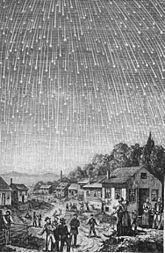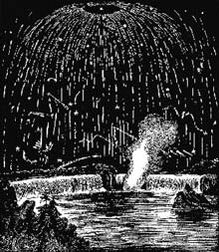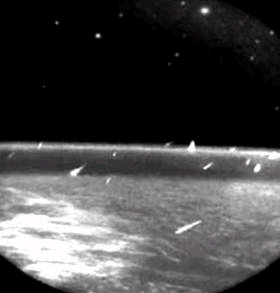Leonids facts for kids
Quick facts for kids Leonids |
|
|---|---|

A Leonid meteor during the peak of the Leonids in 2009
|
|
| Pronunciation | /ˈliːənɪdz/ |
| Discovery date | 902 AD (first record) |
| Parent body | 55P/Tempel–Tuttle |
| Radiant | |
| Constellation | Leo |
| Right ascension | 10h 17m |
| Declination | +21.6° |
| Properties | |
| Occurs during | 3 November – 2 December |
| Date of peak | 17 November |
| Velocity | 70–71 km/s |
| Zenithal hourly rate | 15 |
The Leonids are a famous meteor shower that happens every year. They are known for their amazing "shooting stars" and sometimes even "meteor storms." These storms happen about every 33 years and can fill the sky with thousands of meteors!
The Leonids get their name because they seem to come from the constellation Leo, which looks like a lion. This meteor shower is linked to a comet called 55P/Tempel–Tuttle. The best time to see the Leonids is usually around November 17th.
Contents
What are the Leonids?
The Leonids are tiny pieces of rock and dust, called meteoroids. They are left behind by the comet 55P/Tempel–Tuttle as it travels through space. Imagine a dusty trail left by a car – that's similar to what a comet leaves behind!
Every year, Earth passes through these dusty trails. When the meteoroids hit Earth's atmosphere, they burn up. This burning creates bright streaks of light that we call meteors or "shooting stars."
How Fast and Bright are They?
The Leonids are super fast! They hit our atmosphere at about 70 kilometers per second. This makes them the fastest annual meteor shower.
Even small Leonids, about the size of a grain of sand, can create bright flashes. Larger ones, around 10 millimeters (like a small pebble), can be as bright as the star Sirius. Sometimes, even bigger ones create "fireballs" that are as bright as the planet Venus!
What are Meteor Storms?
Most years, you might see a few Leonids per minute. But every 33 years or so, Earth passes through a much thicker part of the comet's dust trail. This causes a "meteor storm." During a storm, you can see hundreds or even thousands of meteors per hour! Some past storms have shown over 100,000 meteors in an hour.
History of Leonid Showers
People have been watching the Leonids for a very long time. Records of these meteor showers go back to 902 AD.
The Great Storm of 1833
One of the most famous Leonid events happened on November 12-13, 1833. This was a truly spectacular meteor storm. People across North America saw the sky filled with what looked like falling stars. Some estimates say over 100,000 meteors fell every hour!
This event was so amazing that it helped scientists understand meteors better. Before this, many people thought meteors were just something happening in Earth's air. But after 1833, scientists like Denison Olmsted realized they came from space. He noticed the meteors seemed to come from the Leo constellation. He also guessed they came from a cloud of particles in space.
The 1833 storm was important to many people. Native American nations, like the Cheyenne and Lakota, marked the event in their histories. Famous figures like Abraham Lincoln also remembered it years later.
Later Discoveries
In the 1860s, scientists connected the Leonids to the comet Tempel-Tuttle. They figured out that the comet was the source of all the dust that creates the meteor shower.
Another huge meteor storm happened in 1966. People in the Americas saw an incredible display of meteors. This storm helped scientists learn even more about the different sizes of particles in the meteor trails.
In the late 1990s and early 2000s, scientists got much better at predicting when meteor storms would happen. They could even guess the exact time of the brightest bursts! This was a big step forward in understanding meteor showers.
When to See the Leonids
The Leonids are active from early November to early December each year. The peak of the shower, when you can see the most meteors, is usually around November 17th.
Scientists can now predict how many meteors you might see each year. The number of meteors per hour can change a lot, depending on how dense the dust trail Earth passes through is. For example, in 2008, there was a good outburst with about 99 meteors per hour. In 2009, it was around 79.
While major storms like those in 1833 or 1966 are rare, the Leonids are always a great show for anyone who loves looking at the night sky!
Images for kids
See also
 In Spanish: Leónidas (astronomía) para niños
In Spanish: Leónidas (astronomía) para niños
- List of meteor showers
- Perseids, another famous meteor shower





